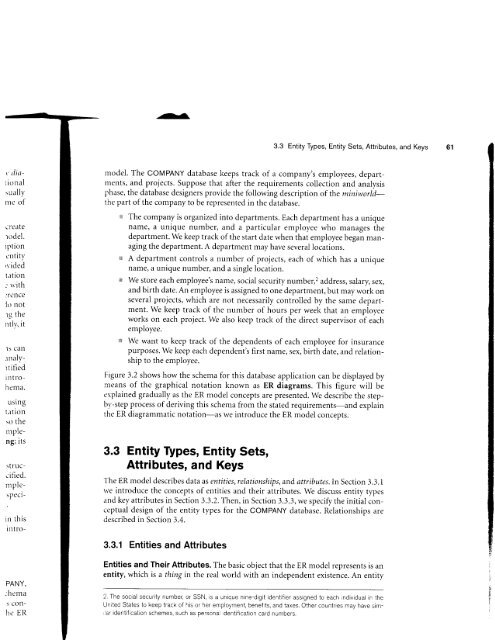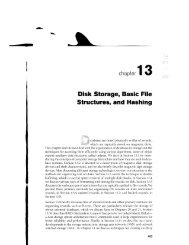this pdf excerpt
this pdf excerpt
this pdf excerpt
Create successful ePaper yourself
Turn your PDF publications into a flip-book with our unique Google optimized e-Paper software.
t diaiional<br />
sually<br />
nrc of<br />
create<br />
roclel.<br />
iption<br />
cntity<br />
'r'ided<br />
t.ltior-l<br />
,'n'ith<br />
-'rcllce<br />
kr not<br />
rtr the<br />
,t..'.<br />
ntlr', it<br />
Llslng<br />
t.rtion<br />
:o the<br />
,r. t.! e -<br />
ng; its<br />
st ruccitred.<br />
,r. t-l c-<br />
speci-<br />
in <strong>this</strong><br />
lnlro-<br />
PANY,<br />
:hema<br />
s collhe<br />
ER<br />
.^3.<br />
3.3 Entity Types, Entity Sets, Attributes, and Keys<br />
model. The COMPANY database keeps track of a company's employees, departments,<br />
and projects. Suppose that after the requirements collection and analysis<br />
phase, the database designers provide the following description of the miniworldthe<br />
part of the company to be represented in the database.<br />
,;: The company is organized into departments. Each department has a unique<br />
name, a unique number, and a particular employee who manages the<br />
department. We keep track of the start date when that employee began managing<br />
the department. A department may have several locations.<br />
,p A department controls a number of projects, each of which has a unique<br />
name, a unique number, and a single location.<br />
# We store each employee's name, social security number,2 address, salary, sex,<br />
and birth date. An employee is assigned to one department, but may work on<br />
several projects, which are not necessarily controlled by the same department.<br />
We keep track of the number of hours per week that an employee<br />
works on each project. We also keep track of the direct supervisor of each<br />
employee.<br />
s We want to keep track of the dependents of each employee for insurance<br />
purposes. We keep each dependent's first name, sex, birth date, and relationship<br />
to the employee.<br />
Figure 3.2 shows how the schema for <strong>this</strong> database application can be displayed by<br />
means of the graphical notation known as ER diagrams. This figure will be<br />
explained gradually as the ER model concepts are presented. we describe the stepb)'-step<br />
process of deriving <strong>this</strong> schema from the stated requirements-and explain<br />
the ER diagrammatic notation-as we introduce the ER model concepts.<br />
3.3 Entity Types, Entity Sets,<br />
Attributes, and Keys<br />
The ER model describes data as entities, relationships, and attribute.s. In Section 3.3.I<br />
\ve introduce the concepts of entities and their attributes. we discuss entity types<br />
and key attributes in Section 3.3.2. Then, in Section 3.3.3, we specifo the initial conceptual<br />
design of the entitv types for the coMPANY database. Relationships are<br />
described in Section 3.4.<br />
3.3.1 Entities and Attributes<br />
Entities and Their Attributes. The basic object that the ER model represents is an<br />
entity, which is a thing in the real world with an independent existence. An entity<br />
2. The social security number, or SSN, is a unique nine-digit identifier assigned to each rndividual in the<br />
United States to keep track of his or her employment, benefts, and taxes. Other countries may have simar<br />
identif catron schemes, such as persona dentification card numbers,<br />
61














